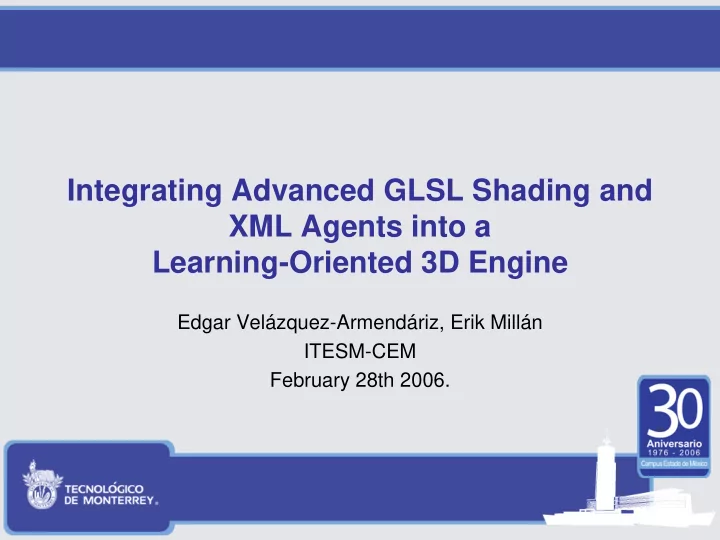

Integrating Advanced GLSL Shading and XML Agents into a Learning-Oriented 3D Engine Edgar Velázquez-Armendáriz, Erik Millán ITESM-CEM February 28th 2006.
Introduction • A lot of Computer Science students chose their major because of their interest on Video Games. • Highly capable commodity GPUs available today. • Development moves towards custom shaders able to render special effects.
Building a 3D Graphics project • Choices for building a serious project: – Existing 3D Engine (OGRE, Irrlicht). • Extremely complex. – Write their own engine. • Difficult, very time consuming. • Would not incorporate advanced features. • How to add AI support for the characters? – Must be implemented on top of the provided API.
Purposed Work • A 3D engine simple featuring: – GLSL shaders. – Shadows. – Particles and collisions. • It also integrates previous work which allows the creation of virtual characters and crowds using images and XML files.
System’s architecture Camera GLM++ FCullerBase FPCamera ModelingCamera «uses» «uses» Object3D «uses» ObjLOD ParticleSet SkyBox
Multi platform and Open Source libraries • Computer Sciencie students use several OS. • Built upon multi platform, open source libraries – Xerces – XML parsing – GLEW – OpenGL Extensions – FreeGLUT – windows management – Fmod – Sound support • Source code compiles both in Visual Studio .NET 2003 and GCC 3.x
GLM++ library • Based on glm library by Nate Robins. • Provides useful yet laborious to implement features: – OBJ file loading. • Performs tangent space matrix calculation, required for per-pixel lighting. • Collision detection initialization. – Texture loading from PNG, BMP and PGM files. – GLSL Shaders abstraction. • Focus on shader logic, not setup details.
Collision Detection
Key Rendering Features • Integrated Frustum Culling for all objects. • Shadow maps. • Per-pixel lighting using Blinn-Phong equations. • Normal mapping and bump mapping. • Wireframe and bounding volume drawing. • Rendering mode may be changed at runtime. – GLSL or fixed pipeline rendering, shadows. • Skybox support.
Normal and Bump mapping
Lighting Equations [ ] ( ) ( ) r r r − = 1 o v ' T B N M v ( ) ( ) r r r r n = ⋅ + ⋅ I I k max 0 , N L I k max 0 , N H out light d light s r r r + L V = r r H + L V ( ) out 1 = + + I I 1 s I frag amb 2
More Normal and Bump mapping examples
GLSL Shadows
GLSL vs. Fixed Pipeline Shadows Fixed Pipeline GLSL
XML Crowds • Based on previous work at ITESM-CEM. • Creates crowds of virtual characters through XML. • These interactive agents can interact with an arbitrary environment using image based collision and height maps. • The crowd’s members can be shaded using custom GLSL programs, and they also cast and receive shadows.
Agent’s XML Code example <procedure name=" wander "> <state name=" init " initial=" true "> <probset cumulative=" true "> <option prob=" 25% "> <behavior type=" turn " style=" run " angle=" 50 " time=" 0.5 " /> </option> <option prob=" 25% "> <behavior type=" turn " style=" run " angle=" -50 " time=" 0.5 " /> </option> <default> <behavior type=" go " style=" run " dist=" 5 " time=" 0.5 " /> </default> </probset> <return /> </state> </procedure>
Height and Collision Maps Height map Collision Map
Engine: 0.05 sec. Results Maya: 11 sec.
Conclusions • We have presented a 3D engine for students in computer graphics and artificial intelligence. • Resulting visual quality encourages further exploration of shading programs and autonomous crowds programming. • The portability of this platform allows the use of a variety of hardware platforms.
Future Work • XML multiple level-of-detail mesh specification. • Use of OpenGL Framebuffers for direct rendering. • Add communication capabilities between characters. • Communication between different environments using networks.
Integrating Advanced GLSL Shading and XML Agents into a Learning-Oriented 3D Engine Edgar Velázquez-Armendáriz, Erik Millán ITESM-CEM February 28th 2006.
Recommend
More recommend